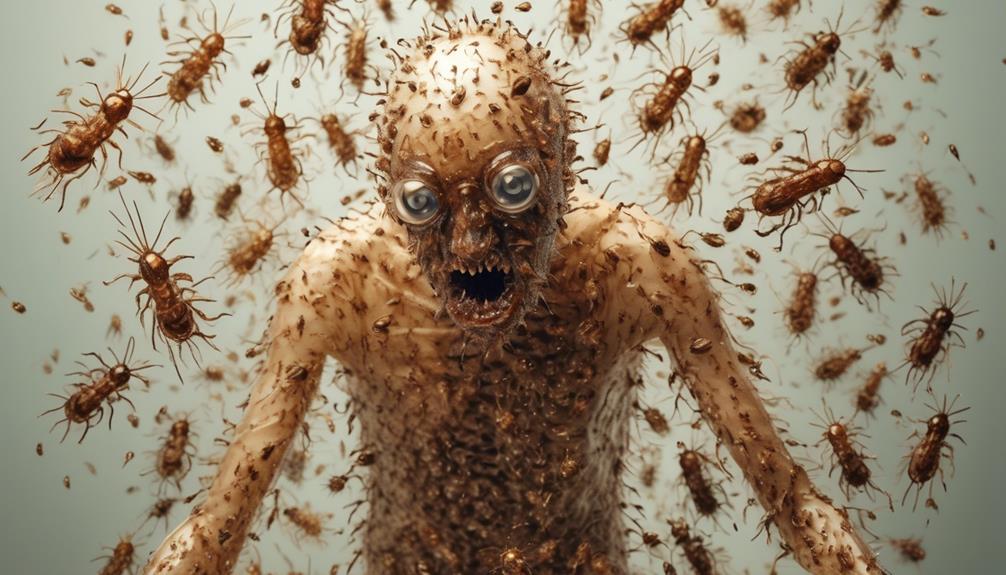Like a faint echo, BPD fleas can unknowingly seep into our actions, shaping how we handle our connections and control our feelings. Identifying these patterns is only the start; comprehending where they stem from and how they affect us is vital for our overall health.
As we explore the complexities of BPD fleas, we uncover the intricate dance between empathy and self-preservation, shedding light on the intricate tapestry of human connection.
Key Takeaways
- Recognize and address learned behaviors early to prevent destructive relationship patterns.
- Seek support from therapy and networks to overcome BPD 'fleas'.
- Practice self-awareness and establish healthy boundaries to manage 'fleas'.
- Professional help, including therapy and medication, is crucial for addressing 'fleas' impact.
Understanding Bpd Fleas
In our relationships with individuals who've Borderline Personality Disorder, it's crucial to understand the concept of BPD 'fleas' and how they can impact our behaviors. BPD 'fleas' are learned behaviors that can be picked up from being in close contact with a person suffering from this disorder. These behaviors might include unconsciously mimicking abusive or manipulative actions, even if we don't intend to do so. It can be challenging for those who care for individuals with BPD to navigate these learned behaviors, especially if they were once an abuse victim themselves. The key is to recognize when these traits or behaviors aren't aligned with our usual personality and to seek the necessary support from our network.
Having a strong support network is essential in addressing and overcoming these 'fleas'. Therapy can also play a crucial role in helping us identify and work through these learned behaviors. By acknowledging and confronting these 'fleas', we can break the cycle and cultivate healthier relationships while gaining a deeper understanding of ourselves.
Common Fleas in BPD

Understanding the common fleas associated with Borderline Personality Disorder sheds light on the subtle yet impactful ways these learned behaviors can influence our interactions and well-being. Individuals with BPD may unknowingly pick up behaviors like imitating manipulative actions such as gaslighting or emotional blackmail. This can lead to unintentionally adopting traits like impulsivity, instability, or a fear of abandonment from being around someone with BPD. Fleas can also manifest as emotional dysregulation, intense mood swings, or self-destructive behaviors mirroring those of individuals with BPD. Moreover, learning unhealthy coping mechanisms such as self-harm or substance abuse can result from internalizing these fleas. By recognizing and addressing these learned behaviors early on, we can prevent perpetuating destructive patterns in our relationships.
| Common Fleas in BPD | Description | Impact |
|---|---|---|
| Imitating Manipulative Behaviors | Copying actions like gaslighting or emotional blackmail from individuals with BPD. | Can lead to toxic communication patterns and strained relationships. |
| Adopting Traits | Unintentionally picking up impulsivity, instability, or fear of abandonment from those with BPD. | May result in personal struggles with emotional regulation and trust issues. |
| Emotional Dysregulation | Experiencing intense mood swings, difficulty controlling emotions, similar to those with BPD. | Can hinder effective communication and decision-making skills. |
| Unhealthy Coping Mechanisms | Learning harmful ways to cope, like self-harm or substance abuse, from individuals with BPD. | Poses risks to mental and physical health, potentially leading to addiction. |
Impact on Relationships
Experiencing the impact of BPD fleas on relationships can be profound and multifaceted. When an individual unknowingly adopts disordered behaviors from a loved one with a personality disorder, it can lead to distorted communication patterns and emotional responses within the relationship. This unintentional mimicry may result in enabling abusive behavior or struggling to set clear boundaries, which can detrimentally affect the dynamics between the individuals involved.
Furthermore, BPD fleas can contribute to self-doubt, cognitive distortions, and the adoption of negative coping mechanisms within the relationship. Recognizing and addressing these fleas is crucial for maintaining healthy and balanced relationships, as it allows for the identification and mitigation of behaviors that stem from the influence of a loved one's personality disorder.
Strategies for Managing Fleas

Recognizing fleas as learned behaviors from living with someone with a personality disorder is essential when developing strategies for managing their impact.
It's crucial to practice self-awareness to identify and address any fleas that may have developed within us. By acknowledging these behaviors and their origins, we can start working on overcoming them.
Seeking therapy or support groups can provide valuable tools and insights to effectively manage and work through these learned responses.
Establishing healthy boundaries is another key aspect in preventing fleas from influencing our behavior and relationships. Learning to set and maintain boundaries can help us navigate challenging situations and interactions more effectively.
Utilizing mindfulness techniques can also aid in controlling and overcoming any flea-related responses that may arise. By imitating or emulating healthier behaviors and responses, we can gradually replace flea-driven reactions with more constructive ones, fostering personal growth and improved relationships.
Seeking Professional Help
Seeking professional help for managing BPD fleas is a crucial step towards understanding and addressing the impact of these learned behaviors. When imitating or emulating a family member with a personality disorder, it's essential to seek the right support.
Here are three key points to consider:
- Specialized Mental Health Professionals: Consulting a mental health professional experienced in treating personality disorders is vital. They can provide tailored strategies to manage BPD fleas effectively.
- Cognitive-Behavioral Approaches: Therapy focusing on cognitive-behavioral approaches can help individuals identify triggers and patterns associated with BPD fleas. This approach aids in understanding and overcoming these challenging behaviors.
- Medication and Support Networks: In some cases, psychiatrists may prescribe medication to alleviate specific symptoms related to BPD fleas. Additionally, engaging in support groups and peer counseling can offer valuable insights and emotional support during the recovery process.
Frequently Asked Questions
What Is the Hardest Mental Illness to Live With?
Living with a challenging mental illness can be overwhelming. The hardest one for us to manage is subjective, as each illness presents unique struggles.
Borderline Personality Disorder, with its intense emotional instability and impulsive behaviors, can be particularly difficult. Symptoms like fear of abandonment and self-harming behaviors make it a tough battle.
Seeking professional help, therapy, and support networks are vital for managing these challenges effectively.
What Are the 4 Types of Bpd?
When it comes to Borderline Personality Disorder (BPD), there are four distinct types: Discouraged, Petulant, Impulsive, and Self-Destructive. Each type presents unique challenges and behaviors.
Discouraged Borderline individuals struggle with feelings of inadequacy, while Petulant Borderline individuals exhibit passive-aggressive tendencies.
Impulsive Borderline individuals engage in risky behaviors without considering consequences, and Self-Destructive Borderline individuals battle self-harm and self-sabotage.
Understanding these types is crucial for effective support and treatment.
What Does a BPD Episode Look Like?
When we look at a BPD episode, we see intense emotional reactions like anger, sadness, or anxiety. Impulsive behaviors, such as substance abuse or reckless actions, may surface. Fluctuations in self-image are common, leading to feelings of worthlessness or grandiosity.
Suicidal tendencies or self-harm might be present as coping mechanisms. Unstable relationships, fear of abandonment, and efforts to avoid it are prevalent. These elements characterize a BPD episode.
What Is the Life Expectancy of Someone With Bpd?
We should note that individuals with Borderline Personality Disorder (BPD) don't inherently have a reduced life expectancy due to the disorder itself. However, factors like comorbid conditions, self-harm, and suicidal behavior can impact their overall health and longevity.
Seeking proper treatment, therapy, and support is crucial for managing symptoms and improving quality of life. Engaging in healthy coping mechanisms, such as mindfulness practices and DBT, can lead to better mental health outcomes.
Regular monitoring and intervention from mental health professionals can help address challenges and enhance well-being.
Conclusion
In conclusion, navigating BPD fleas can feel like trying to untangle a knot of emotions and behaviors that aren't your own. It's like wearing a coat that doesn't quite fit, but you can't take off.
Recognizing and addressing these learned behaviors is key to maintaining healthy relationships and mental well-being. By seeking help and implementing proactive strategies, we can shed these fleas and reclaim our authentic selves.
Let's unravel the knots together.
Val brings a wealth of knowledge and empathy to our team, crafting articles that touch the heart and enlighten the mind. As an expert writer, she dives deep into the subjects of BPD, offering informative and deeply relatable perspectives. Val’s contributions are instrumental in making complex psychological concepts accessible to our audience, helping to foster understanding and compassion.










